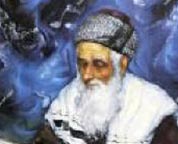 Rabbi Shalom Sharabi — The Rashash
Rabbi Shalom Sharabi — The Rashash
1720 – 1777
The Rashash is considered the father of all contemporary Sephardic kabbalists.
Rabbi Sar-Shalom Mizrachi Didia ben Yitzchak Sharabi, known as the “Rashash” [initials for “Rabbi Shalom Sharabi”], was born in 5480 (1720) in Sana’a, the capital of Yemen. After being miraculously saved from a difficult situation, he fulfilled his vow to go to the Holy Land of Israel in order to live in Jerusalem. After a journey that led him through India, Baghdad and Damascus, he arrived in Jerusalem.
Although he had already established himself in his previous countries of residence as a significant Torah scholar and Kabbalist, he was determined to keep his abilities hidden in the Holy Land. He approached Rabbi Gedalia Chayon, the head of Beit El Yeshiva, the major center for Kabbalah study, and applied for the job of shammash (caretaker). All he asked for in return was a roof over his head and some food. The headmaster took pity on the young orphan and gave him the job.
In this way he was able to stay anonymous yet quench his thirst for Torah. His official job was to wake up the students for the Midnight Rectification Prayer, keep the shelves of holy books in order, bring water and serve hot tea. This enabled him to stand innocently in the corner during lessons as if he was not part of the privileged group of students [which included the famed Chidah], yet he was listening intently.
No one dreamed that this simple shammash was actually a great scholar. Once, an extremely difficult question arose which no one could solve. Young Shalom noticed Rabbi Gedalya’s disappointment and that evening, after all the students left, he wrote down what he knew to be the answer and inserted the note into one of the Rosh Yeshiva’s books.
The next day Rabbi Gedalya was delighted, “A note from G‑d,” he thought. But after this act was repeated a few times, Rabbi Gedalya realized it must be one of his students. He proclaimed, “I decree that the writer of these notes should reveal himself and that we will allot him the respect he deserves.”
For the sake of modesty and his desire to stay anonymous, Rabbi Shalom still did not confess, so the issue remained a mystery.
Chana, the daughter of the Rosh Yeshiva, realized how much her father wanted to find out who was the individual leaving the notes. She decided to spy at nights through the window. Finally, one night she saw the Rashash sticking a paper inside a book on the Rosh Yeshiva’s desk. She immediately notified her father. The Rashash was forced to admit to him his authorship. He pleaded to be allowed to remain hidden, but Rabbi Gedalia took his daughter’s discovery as a sign from Heaven that it was time for the Rashash to be revealed.
After Rav Gedalia’s death in 5507 (1747), the Rashash, then only 27 years old, was appointed Rosh Yeshiva, according to Rabbi Gedalya’s dying wish. He was already married to Chana, with a son whom they named Yitzchak. Among his students were the Chidah, and the Maharit Algazi who became the Rosh Yeshiva after the passing of the Rashash.
He wrote a commentary on the Etz Chaim of which Rav Yeddiya Abulafia said that whoever learns Etz Chaim without the commentary of the Rashash is like a blind man feeling his way in the dark. Among his most famous writings is the Siddur HaRashash, known for its special Kabbalistic intentions for prayer, which has become the standard for all [Sephardic] Kabbalists today.
The Rashash passed on to his heavenly reward on the 10th day of the Jewish month of Shevat, in the year 5537 (1777) at the age of 57, in Jerusalem. He is buried on the Mount of Olives, where his grave is a pilgrimage site until this day.
The great Kabbalist, Rabbi Chaim Pelaji, testified that Rabbi Shalom Sharabi’s soul was that of the holy Ari of Tzefat. Rabbi Yitzhak Kaduri used to say, “One can have memorized all of the written teachings of the Ari, and have studied them and the commentaries upon them in great depth, but if you have not learned the works of the Rashash, you have not yet entered into the study of Kabbalah.” He is considered the father of all contemporary Sephardic kabbalists.
~~~~~~~~~~~~~~~~~~~~~~~~
His Writings:
Perush HaShamash (The caretaker’s Commentary)
Siddur HaRashash – also known as the “Siddur Ha-Kavvanot” — the main prayerbook used today by Kabbalists for prayer, meditation and study, containing extensive Kabbalistic meditations.
Rechovot HaNahar (Roads of the River)
Emet VeShalom (Truth and Peace)
Nahar HaShalom (River of peace) in which he answers 70 questions of the Torah sages of Tunis
Chasdei David (David’s Kindness)
Minhagei Rashash (Customs of the Rashash) – multi-volumed compilations of and commentary upon the customs of the Yemenite Jews. He also produced an exclusive edition of the Shulchan Aruch (“Code of Jewish Law”), where he gives his interpretations of Jewish Law, as well as noting the particular customs of the Shami Yemenite community. These volumes are used by this community still today to reach decisions regarding holidays, marriage and Shabbat services.
In Nahar HaShalom, on page 32a, in response to the question of how he arrived at his great understanding and what written works did he rely upon, the Rashash replies that he relied only upon “Kitvei HaAri,” the written accounts of Rabbi Chaim Vital of the teachings of the holy Ari of Tzefat. He added that he would send them a short pamphlet called “Rehovot HaNahar,” which would lay out the foundational principles that would enable them to understand the Kitvei Ari as he had. Rav Yitzchak Kaduri said, “Until you have learned Rehovot HaNahar, you have not learned Kabbalah.” For this reason it has become the primer book in a number of Kabbalistic yeshivas today.



